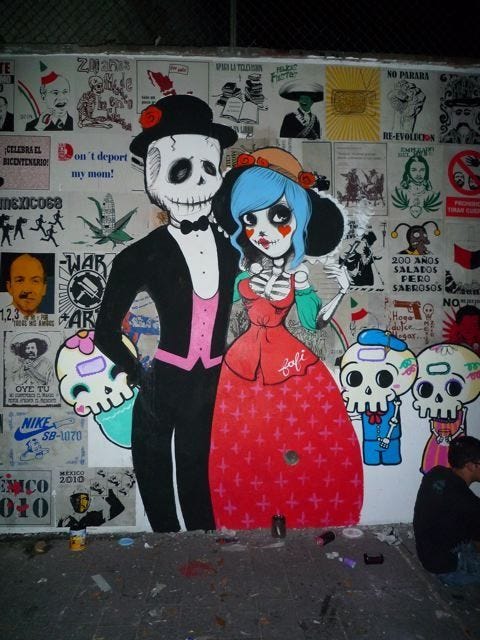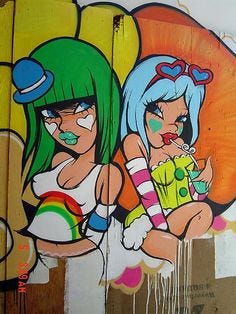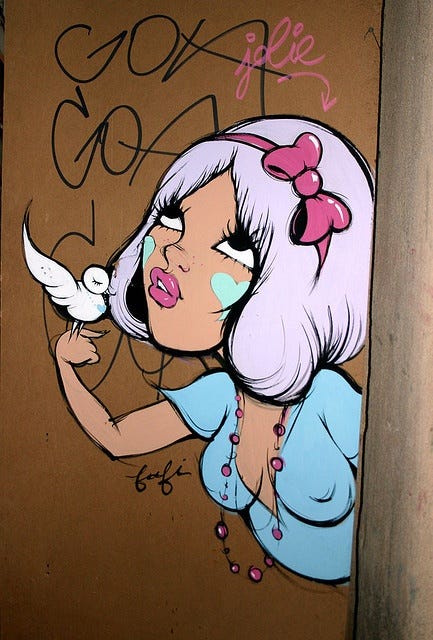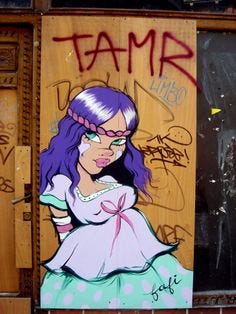Fafi (born Fabienne Saincry, 1975, Toulouse, France) is a pioneering French street artist whose vibrant, cartoonish depictions of women, colloquially known as “Fafinettes”, have transformed urban landscapes and sparked conversations on female empowerment. Since her emergence in 1994, Fafi’s work has evolved from rebellious wall paintings in her hometown to internationally exhibited installations and commercial collaborations with major brands. Her signature use of a bright color palette, exaggerated curves, and playful imagery not only subverts conventional representations of femininity but also challenges the male-dominated world of graffiti.
Growing up in Toulouse, Fafi was raised in an environment marked by both cultural richness and traditional constraints. As detailed on her official website, she began experimenting with graffiti in 1994, a time when street art in France was largely dominated by male voices (Fafi – Official Website). In defiance of conventional expectations, Fafi used the urban canvas to express a unique vision of femininity. Early works focused on bold, curvaceous female figures that would later become known as “Fafinettes.” These early pieces served not only as a form of personal rebellion but also as a statement on reclaiming public space for women, a theme that would remain central throughout her career (Wikipedia, French).
Over the years, Fafi’s style matured into a distinctive visual language characterized by playful proportions, vivid hues, and a blend of comic sensibility with urban grit. Her “Fafinettes”, stylized, voluptuous female characters, are rendered with dynamic brushstrokes and a neon-inspired palette that imbues them with both whimsy and defiant strength. Critics have observed that her work fuses elements of pop art and graffiti while reappropriating traditional feminine icons to challenge the dominant male gaze (Urban Nation; “10 Women Street Artists Who Embody Girl Power”). In an interview with Mural Festival, Fafi explained that her art was a deliberate counterpoint to the hyper-masculine imagery typically found in street art, stating, “I paint to give power to girls, to transform stereotypes into symbols of strength” (Mural Festival).
Fafi’s art has had a significant impact on both street art and feminist discourse. By populating urban spaces with her Fafinettes, she has reimagined the public sphere as one where women can assert their presence and agency. This shift has resonated with a generation of female artists and activists who see her work as a call to action; a visual manifesto of empowerment. Her imagery is not merely decorative; it communicates resilience, self-confidence, and the rejection of traditional gender roles (Supamodu; Urban Nation). Fafi’s work has inspired community projects and workshops that encourage young women to engage in artistic expression, thereby expanding the influence of street art beyond aesthetics into social transformation.
Fafi’s influence extends far beyond the borders of France. As her work began to appear on walls in Paris, New York, and other international urban centers, she quickly gained a global following. Exhibitions and public installations in cities like Los Angeles, Berlin, and Tokyo have showcased her evolving style and affirmed her status as an international street art icon (Artnet; “10 Women Street Artists Who Embody Girl Power”). Moreover, Fafi’s collaborations with local art collectives and cultural festivals have fostered community engagement. For example, her participation in mural projects organized by Urban Nation has not only expanded her audience but also contributed to a broader dialogue about urban renewal and public art’s role in social change (Urban Nation).
In addition to her work on the streets, Fafi has successfully bridged the gap between guerrilla art and the commercial world. Her collaborations with globally recognized brands such as Sony, M.A.C., Adidas, and Chanel have brought her distinctive style into mainstream fashion and product design. These partnerships illustrate how street art can be adapted for commercial purposes without diluting its subversive energy. According to an article on Artnet, Fafi’s commercial projects have helped legitimize street art as a significant contributor to contemporary design, while also ensuring that her message of female empowerment reaches a wider audience (Artnet). By retaining creative control and merging her rebellious aesthetic with marketable products, Fafi has paved the way for future generations of artists to navigate the complex intersection between art and commerce.
Critics and scholars have increasingly recognized Fafi as a transformative force in the evolution of street art. Reviews in publications such as Vogue, Elle, and The Face frequently highlight the empowering nature of her work, noting that her Fafinettes subvert traditional images of female beauty and challenge the objectification prevalent in mainstream media (Festival Mural; Supamodu). Academic studies on urban art have begun to include Fafi’s contributions as key examples of how graffiti can function as a medium for feminist expression. In his study of contemporary street art, art historian Nicholas Ganz cites Fafi alongside other female pioneers for her ability to transform public space into a canvas for social commentary (Ganz). Additionally, scholarly works on feminist art have referenced her work as a case study in re-appropriating gender stereotypes through visual art, contributing to a broader redefinition of femininity in urban culture (Kazbek).
In the digital era, Fafi’s art has found new life through social media platforms. With a substantial following on Instagram (@therealfafi), she engages with a global audience and amplifies her message of female empowerment in real time. Social media has not only allowed Fafi to document her creative process but also to connect directly with fans and fellow artists. This digital presence has been instrumental in spreading her work beyond the confines of physical urban spaces, transforming ephemeral street art into a permanent online legacy (Instagram; Urban Nation). The interactive nature of platforms such as Instagram also enables audiences to share their interpretations and personal connections with her art, further reinforcing its cultural impact.
Fafi’s artistic journey is far from over. As she continues to innovate, her current projects include the development of comic books and immersive public installations that promise to push the boundaries of interactive art. These new endeavors will likely integrate augmented reality and other digital media, reflecting her ongoing commitment to evolving her practice in step with technological advances (Fafi – Official Website). Her legacy is multifaceted: not only has she redefined street art through a distinctly feminine lens, but she has also opened up new avenues for discourse on gender, identity, and public space. Fafi’s enduring influence is evident in the rising number of female street artists and the growing acceptance of street art as a legitimate and impactful form of contemporary art (Urban Nation; “10 Women Street Artists Who Embody Girl Power”).
Fafi’s evolution from a rebellious graffiti artist in Toulouse to an internationally acclaimed cultural icon underscores the transformative power of art. Her playful, vibrant imagery challenges traditional gender norms and reclaims public space as a site of empowerment for women. Through her innovative visual language, impactful commercial collaborations, and dynamic engagement on social media, Fafi has not only reshaped the aesthetics of street art but also redefined its role in contemporary feminist discourse. As her work continues to evolve and inspire, Fafi remains a potent symbol of creative rebellion and a beacon for female empowerment in an ever-changing urban landscape.
References:
Fafi. Wikipedia, The Free Encyclopedia, Wikimedia Foundation, https://fr.wikipedia.org/wiki/Fafi. Accessed 21 Jan. 2025.
Fafi – Bio. Fafi – Official Website, www.fafi.net/bio. Accessed 21 Jan. 2025.
Fafi Biography. Artnet, www.artnet.com/artists/fafi/biography. Accessed 21 Jan. 2025.
Fafi Inspires Women to Create Art! Mural Festival, 25 Aug. 2017, muralfestival.com/fafi-inspires-women-to-create-art/. Accessed 21 Jan. 2025.
Fafi. Urban Nation, urban-nation.com/artist/fafi/. Accessed 21 Jan. 2025.
10 Women Street Artists Who Embody Girl Power. Festival Mural, 7 Mar. 2018, muralfestival.com/10-women-street-artists-who-embody-girl-power/. Accessed 21 Jan. 2025.
Kazbek, Katya. Art: Fafi. Supamodu, 4 Apr. 2019, supamodu.com/2019/europe/fafi-b-1976/. Accessed 21 Jan. 2025.
Ganz, Nicholas. Graffiti World: Street Art from Five Continents. Abrams, 2004.












I love her work!